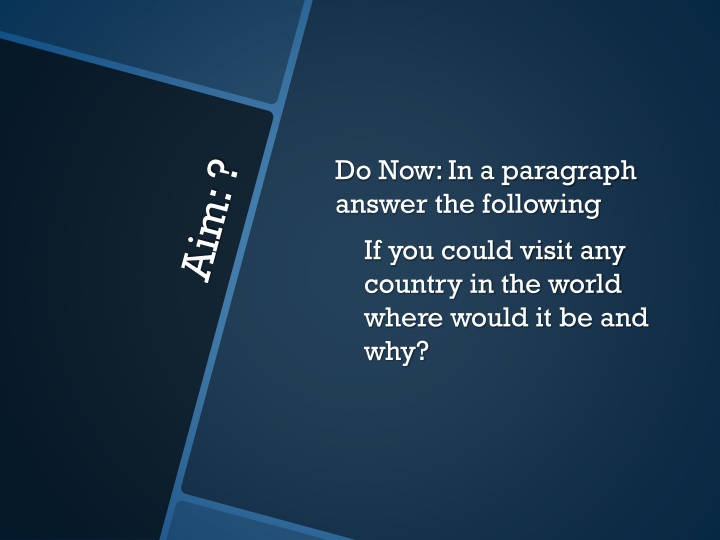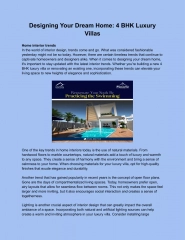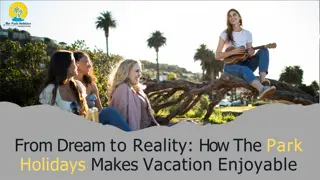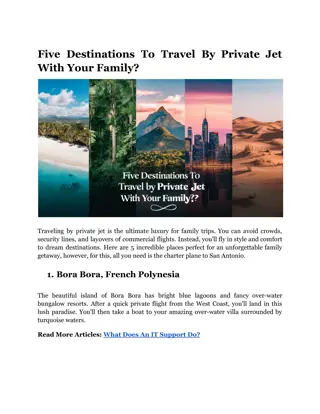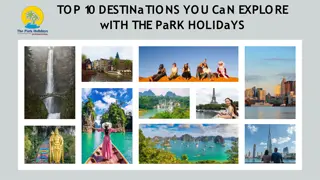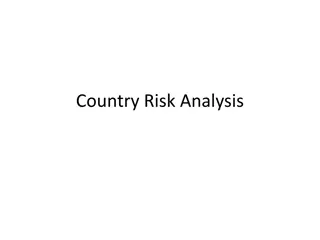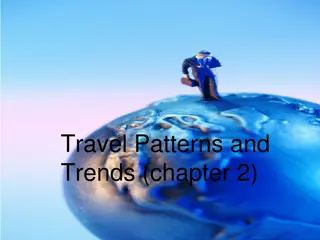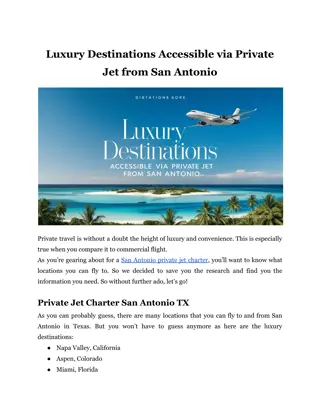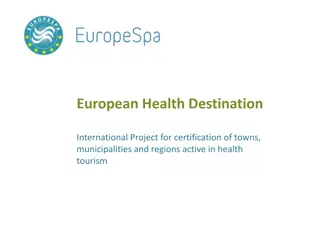Dream Destinations: Choosing the Perfect Country to Visit
If given the chance to travel to any country in the world, the decision can be quite daunting with so many incredible destinations to choose from. Each country offers unique experiences, cultures, landscapes, and histories that can enrich one's perspective and create unforgettable memories. Factors like natural beauty, cultural heritage, cuisine, and adventure opportunities play a significant role in deciding on the ideal travel spot. Ultimately, the choice of the country to visit is a deeply personal one, reflecting individual interests and desires for exploration. Whether it's the picturesque landscapes of New Zealand, the rich history of Italy, the exotic allure of Japan, or the vibrant culture of India, the world is full of wonders waiting to be discovered through travel.
Download Presentation

Please find below an Image/Link to download the presentation.
The content on the website is provided AS IS for your information and personal use only. It may not be sold, licensed, or shared on other websites without obtaining consent from the author.If you encounter any issues during the download, it is possible that the publisher has removed the file from their server.
You are allowed to download the files provided on this website for personal or commercial use, subject to the condition that they are used lawfully. All files are the property of their respective owners.
The content on the website is provided AS IS for your information and personal use only. It may not be sold, licensed, or shared on other websites without obtaining consent from the author.
E N D
Presentation Transcript
Do Now: In a paragraph answer the following If you could visit any country in the world where would it be and why?
At the end of this lesson Students will be able to: Understand what a Brochure is The different types of Brochures Set up a Microsoft Word Document
A brochure also known as a pamphlet is most commonly found around museums, major shop, amusement parks and information booths. They are also found at health clinics and hospitals or interpersonal brochures.
They are designed and used for: A marketing tool to advertise a service or product As an information providing tool
There are many types of brochures, however the most common types are single- sheet brochures that are bi- fold and tri-fold. A bi-fold brochure has 4 parts (two on each side) A tri-fold brochure has 6 parts (three on each side)
Why is it important to plan your brochure layout? First impressions are lasting! The way you layout your information will grab readers attention
Cover page Should be attractive and should include the name of organization/place/company In addition, a photo or graphic should be on the cover page
Type of Writing Style Keep your sentence short and to the point Only give necessary information Use powerful words such as new, results or guarantee
Heading The use of headings draw attention to sections on your brochure The heading should stand out, by having a bigger font and color
Grammar and Spelling It is very important that you proof read your work Grammatical and spelling mistakes takes the attention of the reader s away
Color combinations Make sure you use colors that go together o If you have lime green with shocking pink reader s will not want to read your brochure The most important thing is to grab the reader s attention
Bi-fold brochures are found among us every day: they are one of the most common brochure types. These brochures are economical to print since they are usually a double print folded in half. This folding forms 4 panels: a front-cover, a back-cover, and two internal panels. However, there are other configurations: 8-page, 12- page, 16-page and so on. The front panel works as the front-page, and its main purpose is to introduce the piece and to cause the necessary intrigue or impact to make the viewer want to open it and read the content, while the back- cover is used for contact information; of course this can change. They are more formal that that tri-fold brochures, and are intended for product presentations, catalogues, institutional introductions, etc. Bi-fold brochures can also work as folders in which you can place inserts depending on the prospective interests: this is ideal for trade shows, for example. Large bi-fold brochures have a long lifetime, and are usually read in more detail than small tri-folds.
Tri-fold brochures are one of the most common brochures. They are thin and convenient to carry and tempt viewers to open it as they cause intrigue.These brochures are economical to print since they are basically standard-sized prints on light stocks that are folded in three. They have 6 panels to place information on, which is an advantage over other types of brochures. However, this is not always true: the tri-fold morphology adapts to larger brochures. In these cases, they usually have triple or double pages, and the stock used is of higher quality.Viewers are tempted to open these kind of brochures, as they cause intrigue. So, they are suitable for designs of good impact.They are intended to be handed over to people: ideal to put in folders, or as a more elegant alternative to the flyer in trade shows.
Aim: What is a Brochure? Bi-Fold
Aim: What is a Brochure? Tri-Fold
1. What are the different types of brochures? 2. Where are brochure most commonly found? 3. What should be on the first page? 4. Why is it important to plan the layout of the brochure?
